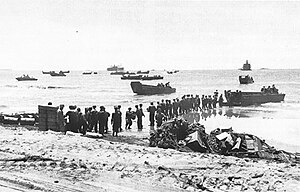| Landing at Aitape | |||||||
|---|---|---|---|---|---|---|---|
| Part of the New Guinea Campaign | |||||||
 Troops unloading supplies at Aitape | |||||||
| |||||||
| Belligerents | |||||||
|
|
| ||||||
| Commanders and leaders | |||||||
|
|
| ||||||
| Units involved | |||||||
| Strength | |||||||
| 22,500 | 1,000 | ||||||
| Casualties and losses | |||||||
|
19 killed 40 wounded |
525 killed 25 captured | ||||||
The Landing at Aitape (code-named Operation Persecution) was a battle of the Western New Guinea campaign of World War II. American and Allied forces undertook an amphibious landing on 22 April 1944 at Aitape on the northern coast of Papua New Guinea. The amphibious landing was undertaken simultaneously with the landings at Humboldt and Tanahmerah Bays to secure Hollandia to isolate the Japanese 18th Army at Wewak. Operations in the area to consolidate the landing continued until 4 May, although US and Japanese forces fought further actions in western New Guinea following a Japanese counter-offensive that lasted until early August 1944. Aitape was subsequently developed into an Allied base of operations and was used by Australian forces throughout late 1944 and into 1945 during the Aitape–Wewak campaign.